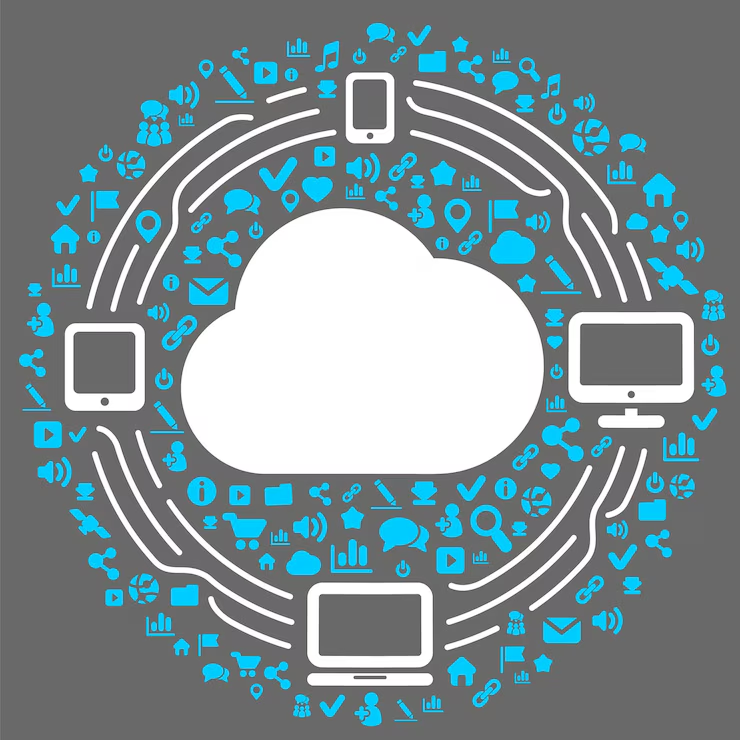The digital transformation of the present day has brought about rapid growth from businesses to migrate their services into the cloud. Cloud app development has become an epitome solution for companies that either crave a little or a lot of scalability from their products, services, or solutions, be it flexibility or cost efficiency. This long piece will cover almost everything you need to know about cloud app development-from the rudiments to technologies, its good things and bad things, and real-life applications. As a startup or an enterprise, being in the know of how exactly a cloud application works can bring ideas about innovations, better performance, and a greater reach worldwide.
Understanding Cloud App Development
What is a Cloud Application?
A cloud application is a software application containing both cloud-based and local components and whose remote servers are used predominately for processing logic, while a user interface is provided with a web browser or app interface. Unlike traditional software applications which must be loaded on each user's hardware, cloud apps make it possible for businesses to remain agile and more cost-effective because they don't need as much hardware.

Key Components of Cloud App Development
Frontend: That front end of an application typically created using HTML, CSS, JavaScript, and frameworks such as React or Angular.
Backend: Server-side logic typically built with Node.js, Python, or Java, handles operations such as authentication and business logic.
Database: Cloud databases, such as Firebase or MongoDB Atlas, are present to create and maintain seamless storage and retrieval of data.
Cloud APIs: Third-party services such as payment gateways, dynamic maps, messaging, and AI tools integrate into the applications using APIs.
Benefits of Cloud App Development
Scalability and Flexibility
Cloud platforms automatically scale to accommodate the user demand; thus, your app will not breakdown while handling surging traffic when there is an increase.
Cost Efficiency
With pay-as-you-go pricing models, upfront infrastructure costs are avoided. You only pay for the resources you consume.
Automatic Updates and Maintenance
Updates and security patches are provided by cloud providers on base, so your app is secure and up-to-date without any work from you.
Accessibility and Cross-Platform Usage
Users can access apps from any device and any location, spanning all mobile, desktop, and web environments.
Enhanced Data Security and Backup
Increased data protection through integrated backup and recovery features further simplifies the fallen scope of accidental data loss.
Faster Time to Market
Rapid deployment and CI/CD pipelines speed up time-to-market for businesses to introduce their products sooner and adapt faster.
Types of Cloud App Deployment

Public Cloud Apps
The public cloud applications are high-scalable and cost-efficient. Instantly hosted by a third-party provider like AWS or Azure, public cloud apps consume resources at a competitive rate.
Private Cloud Apps
Private cloud applications give dedicated infrastructure resources exclusively up to a single organization so that the user will have higher control and security along with more customizable options.
Hybrid Cloud Apps
They are the public and private in a combined use with greater flexibility. The enterprises apply such models where sensitive data are on private clouds while the scalability advantages of the public clouds are used.
Community Cloud Solutions
This would be infrastructure shared by some specific community or organization as educational institutions or it may have other parameters such as a government body.
Cloud App Development Process
Planning and Requirement Analysis
Define goals, target audience, features, and tech stack. Involve stakeholders to align business objectives with technical feasibility.
Cloud Architecture Design
Cloud infrastructure, scalable and secure, has been designed in performance, fault tolerance, and costs.
Development and API Integration
The application is coded and necessary APIs integrated like those of Firebase Auth, Stripe, Google Maps, or Twilio.
Testing and Quality Assurance
Automated and manual testing processes ensure quality; load testing, security testing, and regression testing are of them.
Deployment and Cloud Hosting
They host applications over AWS EC2, Google App Engine, and Azure App Services. Use container orchestration for better control.
Maintenance and Continuous Monitoring
Keep a check on monitoring and maintaining all performance-related activities.
Technologies Used in Cloud App Development
Frontend Frameworks
React, Angular, Vue.js offer localized UI and reactive performance.
Backend Technologies
Node.js, Python (Django/Flask), Java (Spring Boot), .NET provide for formidability on the server-side.
Cloud Platforms
AWS, Microsoft Azure, Google Cloud Platform, IBM Cloud give a global scope to access features while still having a secure infrastructure.
Cloud Databases
Firebase, MongoDB Atlas, Amazon RDS, Google Firestore guarantee availability, integrity, and real-time synchronization in data.
DevOps & CI/CD Tools
Jenkins, Github Actions, GitLab CI/CD, Docker, Kubernetes streamline development cycles and maintain continuous integration and delivery.
Cloud App Architecture
d App Architecture
Multi-Tenant Architecture
Many people are using the same application that has an isolated data environment. Efficient resource utilization and cost savings.
Microservices and Serverless Architecture
Decomposes the application into small services that are managed independently. It enhances modularity and decreases dependencies.
Containers (Docker, Kubernetes)
Consistently packages software in isolated environments, both in development and production.
API-first Development Model
It prioritizes robust API design for scalability and third-party integration, further enhancing interoperability.
Cloud App Security Best Practices
Identity and Access Management (IAM)
Restrict access to resources by employing role-based access control (RBAC).
Data Encryption
Encryption applies during transit (SSL/TLS) and at rest using AES-256.
Regular Security Audits
Periodic assessments to find and fix intrusions or other vulnerabilities can use OWASP ZAP or Burp Suite.
Compliance (GDPR, HIPAA, ISO)
Depending on what is exact data protection will be required. These are essential whether a person's app is in health care, finance, or e-commerce.
Common Challenges in Cloud App Development
Data Security Concerns
Sensitive data, therefore, is prone to being compromised and requires strong levels of access control and encryption.
Vendor Lock-in
To be dependent on a single cloud provider is sometimes considered risky and inflexible. Therefore, the inability to adopt proper means to mitigate this scenario is by using open-source tools or adopting a multi-cloud strategy for improved flexibility.
Downtime and Reliability
Service downtimes cause a disruption in app availability. The SLA and failover mechanisms are good risk mitigators.
Cost Overruns
High bills accrue from unrestrained scaling and bad resource management. Cost control can be exercised through regular audit and budgeting tools.
Integration Complexities
Integration of multiple services and APIs can be quite a technical challenge. Use of standardized protocols and middleware tools would go a long way in addressing this problem.
Cost of Developing a Cloud Application
Factors Affecting Cloud App Development Cost
- Complexity of App
- Features and Integrations
- Design and UI/UX
- Team Rates for Development
- Costs of the Cloud Service
Cost Breakdown
- Design: 10-15%
- Development: 50%
- Cloud Hosting: 20%
- Maintenance: 15%
- Cost-saving Tips and Practices
- Build using open-source tools.
- Select serverless architecture.
- Use cloud credits or free tiers.
- Put monitoring and scaling on auto.
Cloud App Development for Different Industries

Healthcare
Cloud EHR systems, Telemedicine apps enable better data sharing, patient engagement, and remote care.
E-commerce
Scalable product catalogs, real-time analytics, and seamless checkout experiences drive higher conversion rates.
Education
Virtual classrooms, LMS platforms, and online assessments help institutions scale and personalize learning.
Finance
Secure banking, trading, and digital wallet applications enhance convenience and regulatory compliance.
Logistics and Transportation
Real-time tracking, route optimization tools, and fleet management systems increase efficiency.
Case Studies of Successful Cloud Applications
Zoom: Video conferencing scalable with cloud back-end for millions of users; Dropbox: Cloud storage and sharing platform for people and businesses; Salesforce: SaaS CRM platform for global customer relationship management; and Netflix uses the cloud to stream content globally and recommends based on user preferences.
Explore the Top 5 Cloud App Development Companies in 2025
1. InfimintusTech
Headquarters: Indore, Madhya Pradesh, India
Website: infimintustech.com
Overview:
InfimintusTech is a future-forward and fast-upcoming brand in the IT sphere specializing in Cloud App Development that provides advanced development solutions to startups and SMEs all over the world.
Focused on scalability, security, and most importantly user experience, InfimintusTech offers complete full-cycle cloud application development services across various industries.
Cloud App Development Capabilities:
- End-to-end development of cloud-native web and mobile apps.
- Expertise in AWS, Azure, and Google Cloud integrations.
- Microservices, serverless architecture, and containerization.
- Real-time data processing, DevOps automation, and CI/CD pipelines.
Custom enterprise software and SaaS solutions on cloud.
Industries Served:
Healthcare, E-commerce, Real Estate, Edtech, Fintech, Logistics.
Why Choose InfimintusTech:
- Agility in development coupled with dedicated project managers.
- Low cost, especially favorable for startups and mid-sized companies.
- Very good customer retention as well as long-term client partnerships.
- Open communication and post-deployment suppor.
2. Amazon Web Services (AWS)
Headquarters: Seattle, Washington, USA
Website: aws.amazon.com
Summary:
Global power in cloud service, unmatched scale and used by Netflix, Airbnb, and others.
3. Microsoft Azure
Headquarters: Redmond, Washington, USA
Website: azure.microsoft.com
Summary:
Proven cloud platform, good enterprise tools, DevOps, and hybrid cloud capabilities.
4. Google Cloud Platform (GCP)
Headquarters: Mountain View, California, USA
Website: cloud.google.com
Summary:
Preferred cloud application for analytics-driven, intelligent, AI-powered, and mobile-first applications.
5. IBM Cloud
Headquarters: Armonk, New York, USA
Website: www.ibm.com/cloud
Summary:
Just right for those regulated industries with enterprise-grade infrastructure close to AI integration.
Summary Table:
| Rank |
Company |
Key Strength |
Best For |
| 1 |
InfimintusTech |
Agile, affordable, full-cycle cloud app dev |
Startups, SMEs, Indian/global clients |
| 2 |
AWS |
Most comprehensive global cloud platform |
Enterprises, high-scaling apps |
| 3 |
Microsoft Azure |
Seamless enterprise and hybrid integration |
Large businesses, .NET-based solutions |
| 4 |
Google Cloud |
Strong in AI, analytics, and mobile backends |
Data-heavy apps, startups, ML/AI products |
| 5 |
IBM Cloud |
Secure and hybrid cloud for enterprises |
Healthcare, finance, large organizations |
Why Choose InfimintusTech for Cloud App Development?
Our Expertise and Technology Stack
AWS, Azure, Google Cloud, React, Node.js, Python, and other modern technologies.
Portfolio and Success Stories
More than 50 successful projects of a cloud nature across industries, such as healthcare, e-commerce, and finance.
Client-centric Development Approach
Agility and transparency are the ways through which you will remain in control at every point of the development cycle.
Ongoing Support & Maintenance
Around-the-clock monitoring and technical support for high performance and the elimination of the issue.
Future of Cloud App Development
- Integration of AI and ML in cloud apps will help personalize user experience and automate workflows.
- Edge computing will reduce latency by processing data near to the user.
- Green cloud initiatives would help in lowering carbon footprint.
- Integration with IoT will provide real-time data collection and control.
Conclusion
Cloud app development isn't just a trend anymore; it is now requirement for businesses that are future-ready. With scalable, efficient, cost-effective, and safer cloud app development, businesses in all industries now have the chance to innovate and grow. InfimintusTech will help in bringing that dream cloud app development into a reality. Cloud expert offered highly scalable cloud solutions tailored to your business goals and secured.
FAQ's
Q1: What are cloud-based applications?
These software applications are programs that run on remote cloud servers that can be accessed over the Internet, not needing full installation on a local device. Unlike traditional software, it provides scalability, allows accessibility from afar, and provides centralized data storage thus making these the most ideal for modern businesses, startups and enterprise solutions.
Q2: How do cloud applications work?
Cloud applications are ones that stream processes with the structure of cloud computing to store data and application logic and processing power of applications for consumers. In this way, the models available for them are Software as a Service (SaaS), Platform as a Service (PaaS) or Infrastructure as a Service (IaaS), depending on their usage. A user interacts with a web interface or an application, whereas backend logic and databases live within cloud servers, characterized by high availability, seamless updates and real-time collaboration.
Q3: What is the cost of developing a cloud application?
Cloud app development cost can range anywhere from about $10,000-$100,000 and beyond, depending on the complexity, features such as user management, data analytics, API integrations, type of cloud deployment: public, private, hybrid, security requirements and compliance: HIPAA, GDPR, scalability requirements and Dev Ops setup. Expensive custom corporate solutions with AI/ML capabilities or IoT integration can drive the budget even higher.
Custom enterprise-grade solutions with AI/ML capabilities or IoT integrations can push the budget higher.
Q4: Which is the best cloud service provider?
Top Cloud Providers include:
- Amazon Web Services: The all-time service that uplifts broad-ranging services across global infrastructure as well as enterprise-grade security.
- Microsoft Azure: Best adapted with businesses integrating Microsoft tools such as Office 365 and Dynamics.
- Google Cloud Platform (GCP): Service of all-time stand for all big data, artificial intelligence, and machine learning.
- The most reliable one for your project is heavily dependent on the requirements of your project, its scale, its budget, and region of availability.
Q5: Do cloud applications have offline capabilities?
Yes, some cloud applications are engineered to work partially offline through methods like local storage or caching. These applications store user data locally until the device restores internet access, whereupon it quickly gets synchronized with the cloud. This becomes an advantage in field service, retail, healthcare, or working remotely when constant internet connectivity is not guaranteed.
Read Our Another Article:
Search Jobs Here
UI Design Services – Crafting Exceptional Digital Experiences in 2025

















